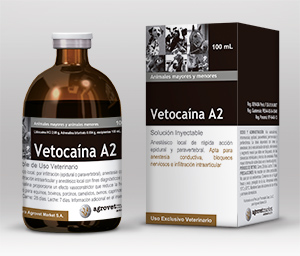Lidocaine hydrochloride 20 mg, 0.04 mg epinephrine bitartrate, excipients qs ad 1 mL

Lidocaine hydrochloride 20 mg, 0.04 mg epinephrine bitartrate, excipients qs ad 1 mL
Noted as a local anesthetic infiltration (epidural or paravertebral) cesarean section, tail cuts, castration, examination and diagnosis of lameness in horses. For intra-articular conductive anesthesia, nerve block (such as the intercostal nerves and brachial plexus mandibular) and subarachnoid infiltration to control clinical pain. As local anesthesia for diagnostic and exploratory purposes. The potent vasoconstrictor action of adrenaline gives you a antihemorrágico effect at the time of surgery, further prolonging the anesthetic effect of lidocaine.
Or nerve conduction block: • diagnostic injections in horses and cows 5-10 mL. • Anesthesia cornual nerve Cow (dehorning): 8-10 mL on each side. Infiltration anesthesia: In cases of repeated administration, the total volume administered should not exceed 0.5 mL / kg bw • Cats: 1 mL. • Dogs: 1-2 mL. • Horses: From 100-200 mL per site for surgery. Sacral anesthesia: Surgical standing in animals: Horses • 5-10 mL (slow administration). • Cows: 4-6 mL (slow administration). • Sheep, goats, camelids: 2-3 mL (slow administration). Epidural anesthesia for surgery in animals lying: • Horses: 25-75 mL (slow administration). • Cows: 15-60 mL (slow administration). • Small Animals: 1.5 mL/10 cm length of the spine (slow administration). The application is subcutaneous, intramuscular, epidural, paravertebral, and peritendinous perinerviosa.
100 mL glass vial,
SENASA Peru: F.59.01.N.0007

© 2014 All rights reserved.
Create a free website